Lightly tangy with a slightly crisp crust and a perfectly chewy crumb, this easy recipe for sourdough bagels can be made in one day or left overnight to ferment. They’re a creative way to use your sourdough starter.
Have you ever had a freshly baked bagel from bagel shop? I don’t mean Einstein Bros. or the slightly mushy kind you get from the grocery store shelves. I mean the kind that were kneaded, boiled, and baked right on the premises, then piled high with cream cheese?
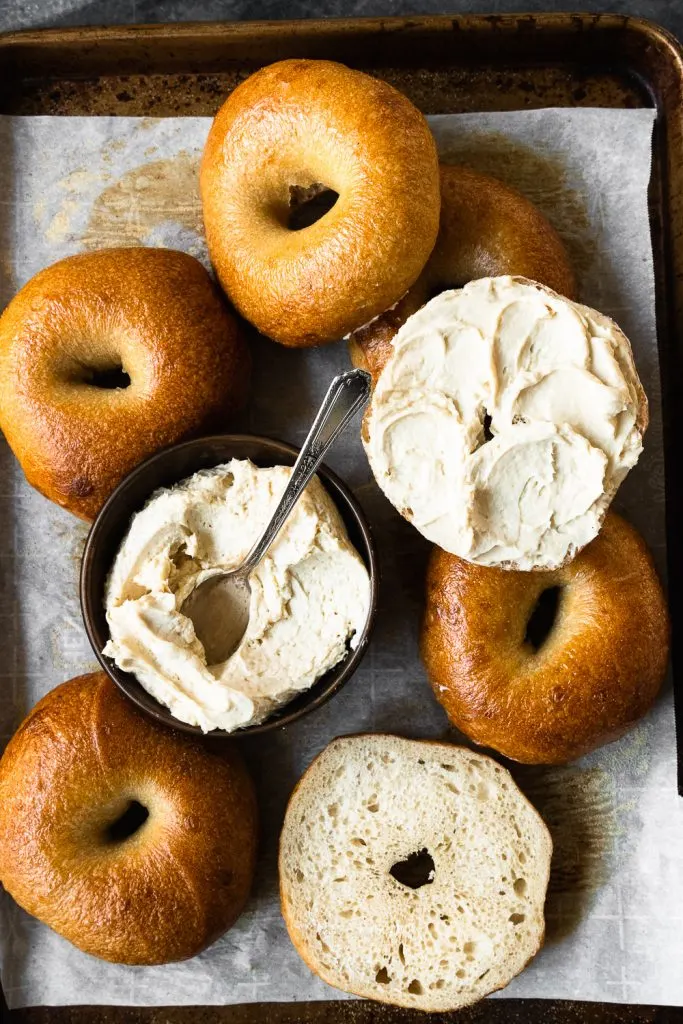
Well, these sourdough bagels are like those, only better. The sourdough starter gives the bagels a complex flavor, and the crust has the perfect amount of chew with a slight hint of crispiness. And the crumb of the bagel is perfectly dense, giving you the glutenous texture that you expect from really good bagels.
A few notes before getting started…
- You’ll need active, bubbling starter for this recipe. If you want to make these bagels in the morning, feed your starter the night before. Or, if you wish to make them in the afternoon or evening for baking the next morning, feed your starter in the morning so that it will be happy and active by the time you want to start mixing the bagels.
- You can boil and bake the bagels the same day you mix them–the process will take 8 to 10 hours total, with about 1 hour of that time being active throughout the process.
- Alternatively, after shaping the bagels and letting them rise, you can place the baking sheets in a large, clean plastic bag and refrigerate it overnight.
Ingredients for Sourdough Bagels
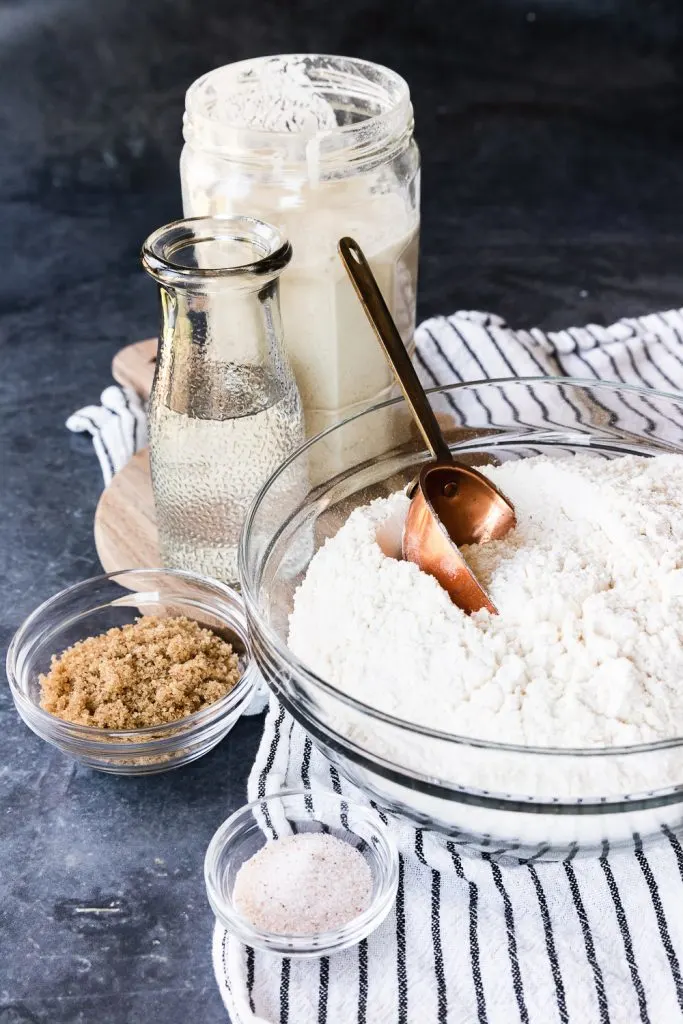
- 3 cups (405 g) bread flour
- 175 ml (169 g) cool water
- 4 T (50 g) brown sugar
- 2 1/2 tsp (15 g) sea salt
- 1 cup (227 g) active, ripe sourdough starter
- 1 T baking soda for boiling
- 1 egg white for egg wash
- Semolina flour or finely ground cornmeal
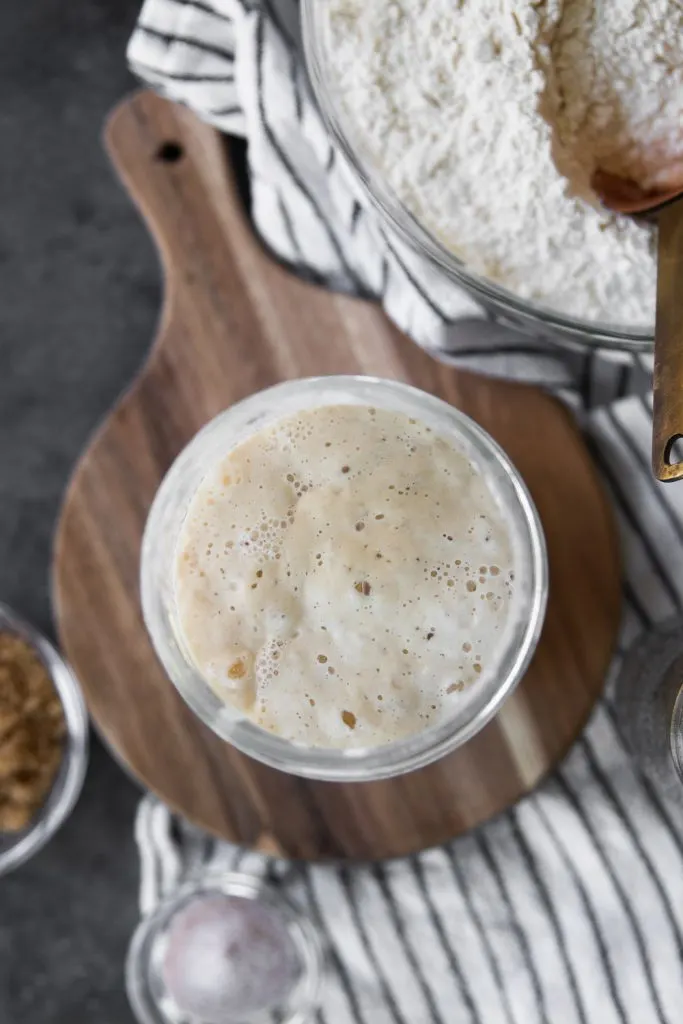
How to Make Sourdough Bagels
Mixing the Dough
In the bowl of a stand mixer, whisk together the flour, brown sugar, and salt.
Add the active starter and water and mix until it’s all combined. Bagel dough has a fairly high flour percentage, so it may take a couple of minutes for all of the flour to be incorporated into the wet ingredients.

Knead the sourdough bagel dough for 8-10 minutes, or until the dough is smooth and stretchy. Take a small portion of dough and spread it out until it’s thin enough to see light through. If the dough has torn and has holes, continue to knead for a few more minutes. If it’s stretching out nicely without tearing, it’s ready for its first rise.
First Rise
Place the kneaded dough into a clean bowl (it doesn’t need to be oiled). Cover it with plastic wrap or a shower cap–something that will prevent the dough from drying out and developing a skin.
Let the bagels rise in a warm place for 4-6 hours, or until the dough is puffed up to about half again it’s size.
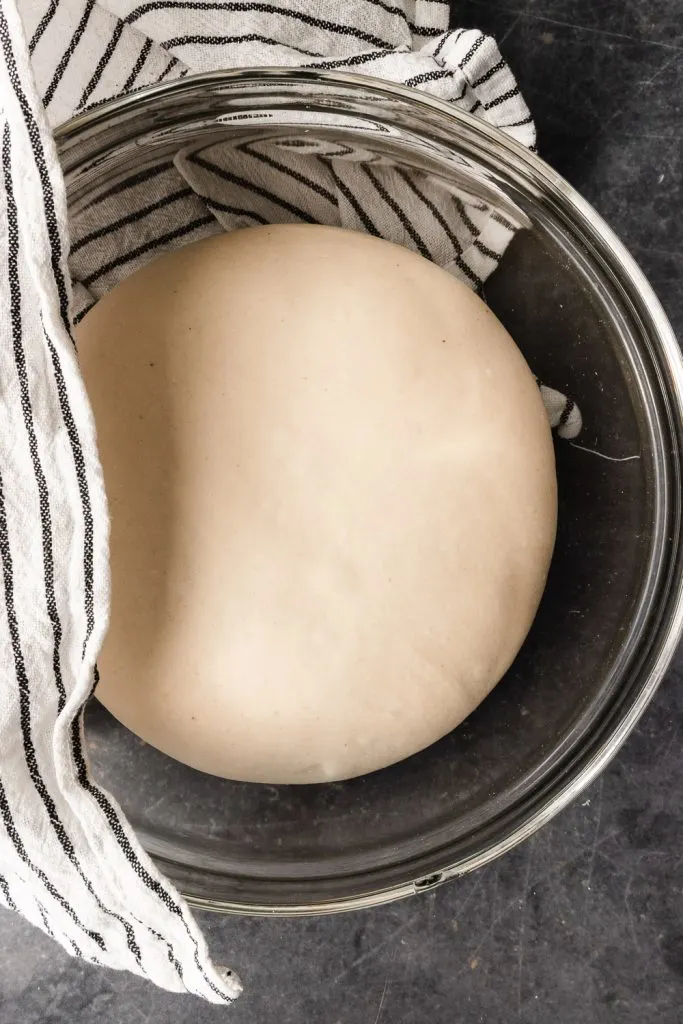
The amount of rise time depends mostly on the temperature of the room the dough is rising in. An oven with the light on is a great place for letting dough rise.
Shaping the Bagels
Line a large baking sheet with parchment paper or a silicone baking mat. Sprinkle it with either fine ground cornmeal or semolina (my preference).
Remove the dough from the bowl it was rising in and divide it into 6 equal pieces. If you have a baking scale, I recommend weighing the complete dough and dividing that number by 6 to figure out how much each piece out how much each piece of dough should weigh.
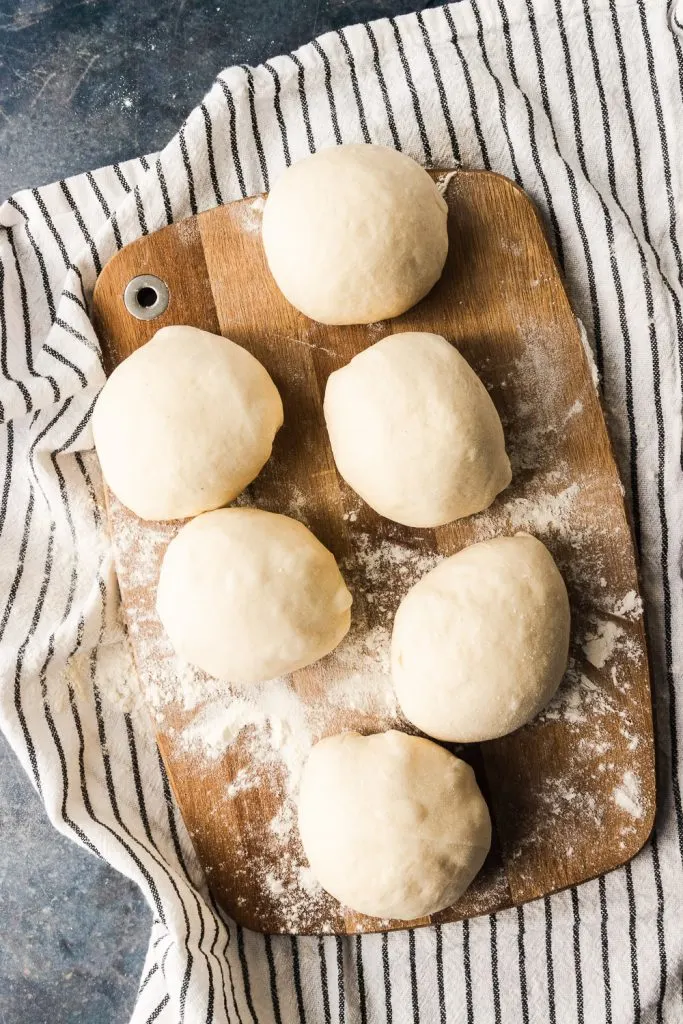
Shape each portion of dough into a ball, then poke a hole through the center with your thumb. Gently work the hole until it’s big enough to fit both of your pointer fingers through in opposite directions.

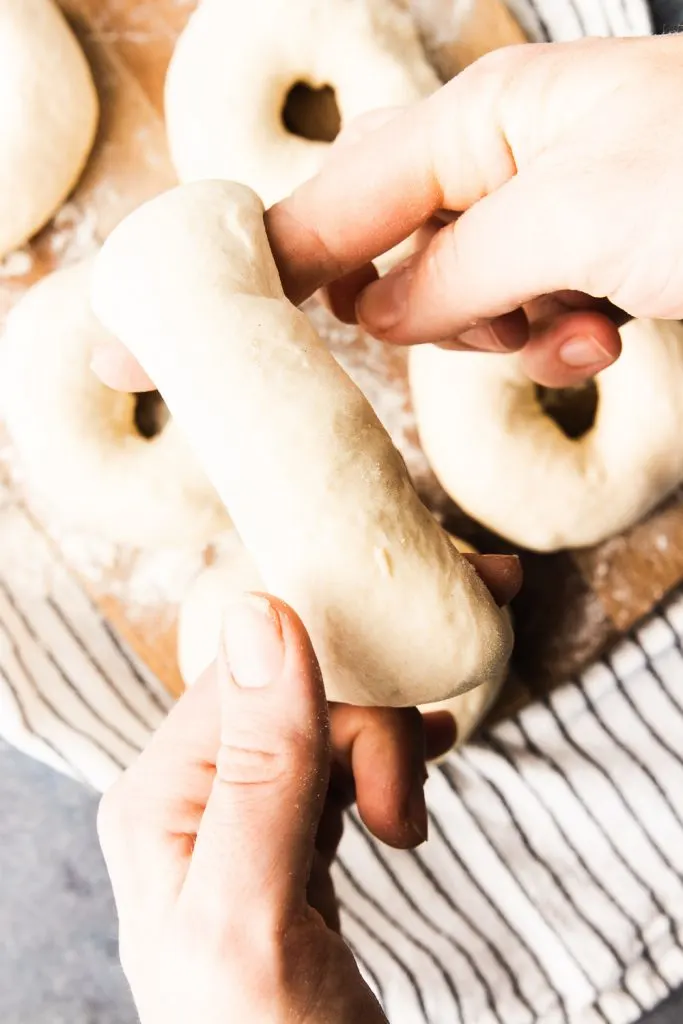
Spin your fingers in circles, carefully stretching and widening the hole in the bagel as you turn them. If the dough starts to feel too tight or fight you, set that bagel down for 5-10 minutes to allow the gluten to relax, then finish stretching it.
Shape all of the bagels this way. You want the holes to be fairly large, since they will close up some as the bagels rise and bake.
Second Rise
Arrange the bagels on the lined, semolina dusted baking sheet with a few inches between each of them. Place the baking sheet in a large, clean plastic bag and fold then end under to keep the sourdough bagels from drying out.
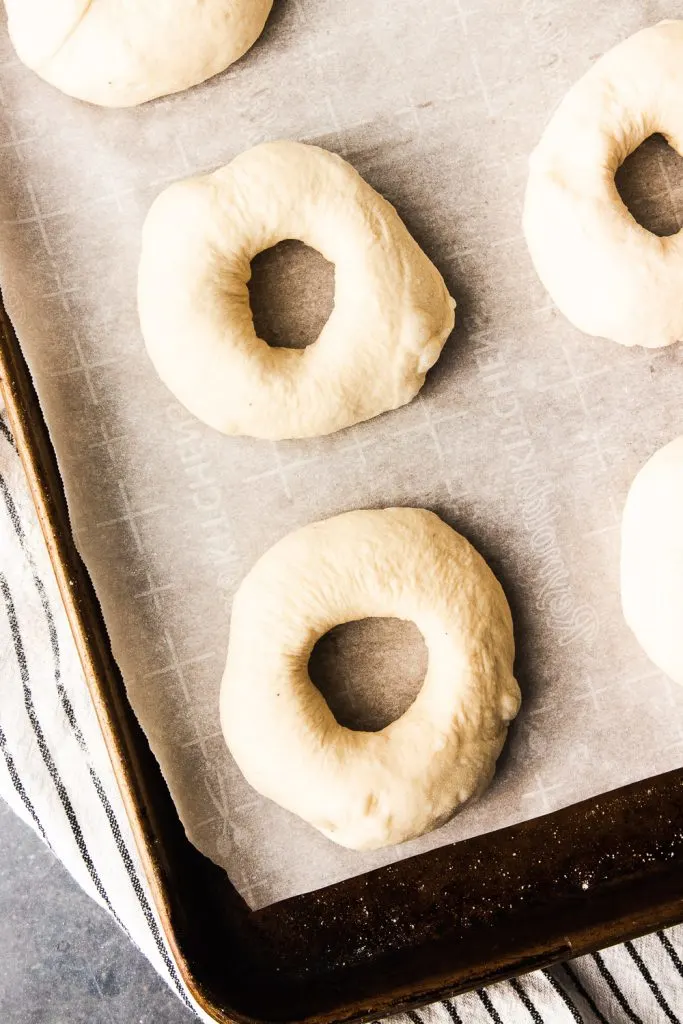
Allow the bagels to rise for 1-2 hours, or until they look slightly puffed. When you touch them lightly, the indentation from your finger should spring back slowly. At this point they are ready to boil and bake, or you can let them ferment overnight.
Letting the Bagels Ferment Overnight {Optional}
After the bagels have been shaped and had their second rise, you can put them in the fridge overnight or up to 24 hours. Remove them the refrigerator and allow them to come to room temperature before boiling and baking. This allows the yeast to become active again. If you boil and cook cold bagels, they’ll be dense and have a poor rise.
Baking the Sourdough Bagels

First, preheat the oven to 400°F. Have some extra semolina or fine ground cornmeal ready.
Boiling The Bagels
In a large pot, boil about 12 cups of water–it doesn’t have to be an exact amount. Once the water is at a rolling, steady boil, add 1 tablespoon of baking soda. It will cause the water to fizz for a second, but should die down quickly.
Carefully place the bagels in the water, one or two at a time, and boil the first side for 30 seconds. Flip the bagel over with a long utensil and boil the other side for another 30 seconds.
Remove the bagels with a slotted spoon or spatula, letting any excess water drain off. Sprinkle the lined baking sheet with a bit more semolina or fine cornmeal, then place the bagel back on the sheet.
Repeat this process until all of the bagels have been boiled. I like to stagger when I put them in (put one in for 30 seconds, flip it, then reset the timer and add the next one). This helps keep any of them for being in the water for more than 1 minutes.
A Note About Boiling Times
You can definitely boil a bagel longer than 1 minute, and it’s really up to you based on what kind of bagel you like. The longer a bagel boils, the denser it will be when baked. Since more of the yeast has been cooked in the boiling process, it will rise far less in the oven. The crust will also be more thick and chewy.
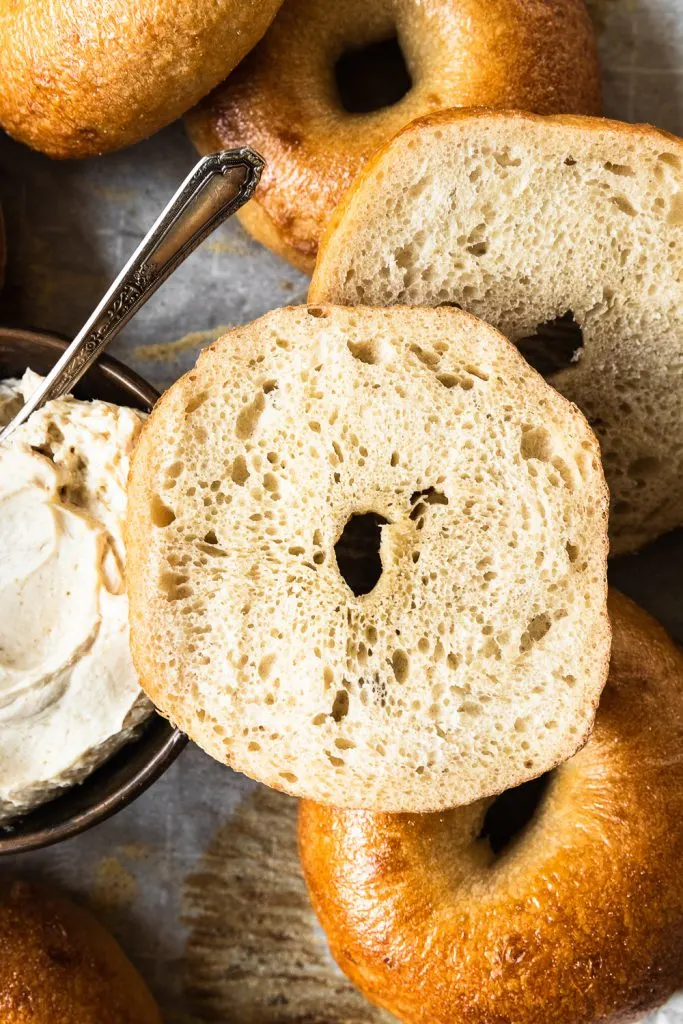
Baking the Bagels
Lightly beat an egg white and use a pastry brush to spread a layer over the top of each bagel.
Place the sourdough bagels in the oven and bake them for 18-20 minutes at 400°F. They should be a deep golden brown all the way around.
Remove the baked bagels from the oven and allow them to cool completely before cutting them open. This prevents the inside from becoming gummy.
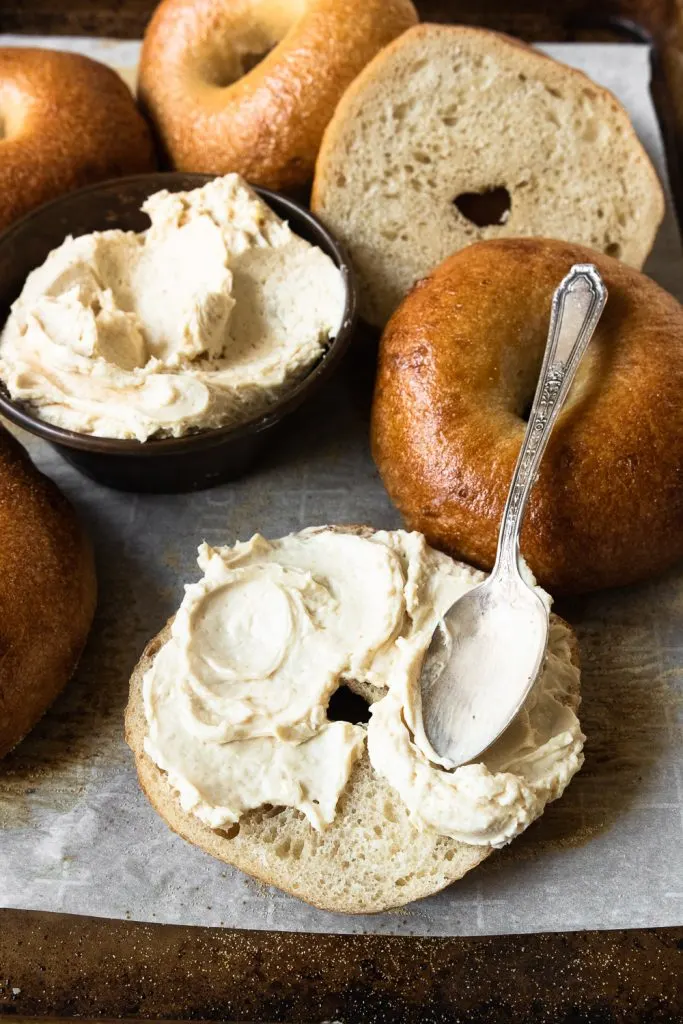
Serving and Storing Sourdough Bagels
When fresh, these sourdough bagels are delicious simply sliced and spread with cream cheese or any topping of your choice. Make a savory breakfast by making smoked salmon bagels. After they are a day or two old, they are best toasted and buttered.
Trying Different Flavors of Sourdough Bagels
- Blueberry Sourdough Bagels: Chop 1/4 to 1/3 cup dried blueberries into small pieces. Knead them in during the last two minutes of knead time.
- Cinnamon Raising Sourdough Bagels: Mix 2 teaspoons of cinnamon into the flour when making your bagel dough. Add raisins gradually during the last two minutes of kneading time. Note: Cinnamon can be a yeast retardant, meaning it slows down the yeast’s activity. Rise times may be slightly longer with cinnamon in the bagel dough.
- Everything Bagels: After spreading the egg wash over the bagels, sprinkle or dip them in everything bagel seasoning (found in most grocery stores).
Other Sourdough Recipes You May Enjoy:
Print
Easy Sourdough Bagels Recipe
- Total Time: 19 hours
- Yield: 6 large bagels 1x
Ingredients
- 3 cups (405 g) bread flour
- 175 ml (169 g) cool water
- 4 T (50 g) brown sugar
- 2 1/2 tsp (15 g) sea salt
- 1 cup (227 g) active, ripe sourdough starter
- 1 T baking soda for boiling
- 1 egg white for egg wash
- Semolina flour or finely ground cornmeal
Instructions
In the bowl of a stand mixer, whisk together the flour, brown sugar, and salt.
Add the active starter and water and mix until it’s all combined. Bagel dough has a fairly high flour percentage, so it may take a couple of minutes for all of the flour to be incorporated into the wet ingredients.
Knead the sourdough bagel dough for 8-10 minutes, or until the dough is smooth and stretchy. Take a small portion of dough and spread it out until it’s thin enough to see light through. If the dough has torn and has holes, continue to knead for a few more minutes. If it’s stretching out nicely without tearing, it’s ready for its first rise.
First Rise
Place the kneaded dough into a clean bowl (it doesn’t need to be oiled). Cover it with plastic wrap or a shower cap–something that will prevent the dough from drying out and developing a skin.
Let the bagels rise in a warm place for 4-6 hours, or until the dough is puffed up to about half again it’s size.
The amount of rise time depends mostly on the temperature of the room the dough is rising in. An oven with the light on is a great place for letting dough rise.
Shaping the Bagels
Line a large baking sheet with parchment paper or a silicone baking mat. Sprinkle it with either fine ground cornmeal or semolina (my preference).
Remove the dough from the bowl it was rising in and divide it into 6 equal pieces. If you have a baking scale, I recommend weighing the complete dough and dividing that number by 6 to figure out how much each piece out how much each piece of dough should weigh.
Shape each portion of dough into a ball, then poke a hole through the center with your thumb. Gently work the hole until it’s big enough to fit both of your pointer fingers through in opposite directions.
Spin your fingers in circles, carefully stretching and widening the hole in the bagel as you turn them. If the dough starts to feel too tight or fight you, set that bagel down for 5-10 minutes to allow the gluten to relax, then finish stretching it.
Shape all of the bagels this way. You want the holes to be fairly large, since they will close up as the bagels rise and then bake.
Second Rise
Arrange the bagels on the lined, semolina dusted baking sheet with a few inches between each of them. Place the baking sheet in a large, clean plastic bag and fold then end under to keep the sourdough bagels from drying out.
Allow the bagels to rise for 1-2 hours, or until they look slightly puffed. When you touch them lightly, the indentation from your finger should spring back slowly. At this point they are ready to boil and bake, or you can let them ferment overnight.
Letting the Bagels Ferment Overnight {Optional}
After the bagels have been shaped and had their second rise, you can put them in the fridge overnight or up to 24 hours. Remove them the refrigerator and allow them to come to room temperature before boiling and baking. This allows the yeast to become active again. If you boil and cook cold bagels, they’ll be dense and have a poor rise.
Baking the Sourdough Bagels
First, preheat the oven to 400°F. Have some extra semolina or fine ground cornmeal ready.
Boiling The Bagels
In a large pot, boil about 12 cups of water–it doesn’t have to be an exact measurement. Once the water is at a rolling, steady boil, add 1 tablespoon of baking soda. It will cause the water to fizz for a second, but should die down quickly.
Carefully place the bagels in the water, one or two at a time, and boil the first side for 30 seconds. Flip the bagel over with a long utensil and boil the other side for another 30 seconds.
Remove the bagels with a slotted spoon or spatula, letting any excess water drain off. Sprinkle the lined baking sheet with a bit more semolina or fine cornmeal, then place the bagel back on the sheet.
Repeat this process until all of the bagels have been boiled. I like to stagger when I put them in (put one in for 30 seconds, flip it, then reset the timer and add the next one). This helps keep any of them from being in the water for more than 1 minutes.
A Note About Boiling Times
You can definitely boil a bagel longer than 1 minute, and it’s really up to you based on what kind of bagel you like.
The longer a bagel boils, the denser it will be when baked. Since more of the yeast has been cooked in the boiling process, it will rise far less in the oven. The crust will also be more thick and chewy.
Baking the Bagels
Lightly beat an egg white and use a pastry brush to spread a layer over the top of each bagel.
Place the bagels in the 400°F oven and bake them for 18-20 minutes, or until you are happy with the coloring on the top. They should be a deep golden brown.
Notes
- After kneading, the dough should be very rubbery and elastic. Don’t be afraid to keep going if you don’t have a very firmy, bouncy dough
- When shaping the bagels, make the hole in the center larger than your instincts tell you. The center will fill in as they rise, leaving you with more of a roll than a bagel shape.
- You could add mixins (cinnamon & raisins, dried blueberries, etc.) at the beginning of the kneading, or sprinkle everything seasoning mix on the top after applying the egg wash.
- Prep Time: 20 minutes active/18 hours resting
- Cook Time: 30 minutes
- Category: Sourdough
- Method: Baking
- Cuisine: Bread





MJ Keri
Monday 6th of January 2025
Easy, great recipe. I sprinkle sesame seeds, big salt, poppy seeds after egg white wash. Yum.
EG
Thursday 7th of November 2024
These turned out so great! Great for when you forget to do it the night before!
Roasted Garlic Butter - Two Cloves Kitchen
Thursday 15th of August 2024
[…] Baked Good Prepare your favorite toast and smear with roasted garlic butter. I love this air fryer roast recipe as the base for an amazing crostini or these tasty sourdough bagels. […]
Sourdough Brioche - Good Things Baking Co
Tuesday 21st of May 2024
[…] are so many creative recipes for using your sourdough starter! Whether it’s sourdough bagels, bread bowls for soup, biscuits, or even cake, you can find all my favorites […]
LB
Friday 26th of January 2024
This is a great recipe - works so much better than others because the author knows her baking science. A proper ratio of starter to flour makes all the difference.